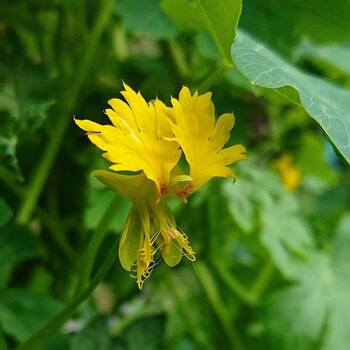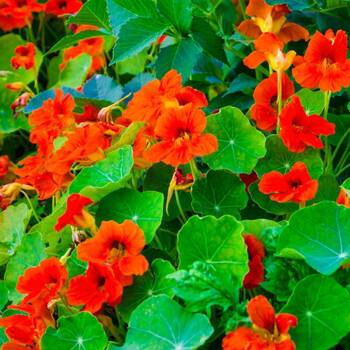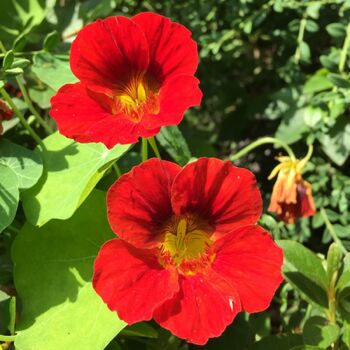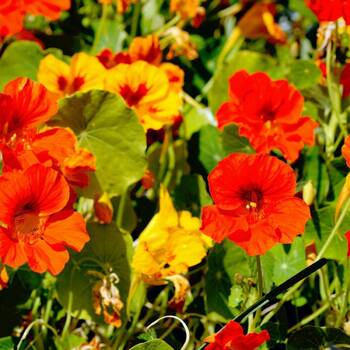
How to Grow Nasturtium Seeds
Grow Guide #2292
Family: Tropaeolaceae
Binomial name: Trolaeolum majus
Life Cycle: Annual
This 'How to Grow' guide details everything a home gardener needs to know to plant, grow and care for Nasturtiums (Trolaeolum majus).
(Canary Creeper Nasturtium (Tropaeolum peregrinum) is a different species but is grown in the same way as nasturtium.)
When to Sow Nasturtium Seeds
Nasturtium is a warm season flower. Use the table below to identify the best time of year to sow nasturtium seeds in your climate.
| JAN | FEB | MAR | APR | MAY | JUN | JUL | AUG | SEP | OCT | NOV | DEC | |
|---|---|---|---|---|---|---|---|---|---|---|---|---|
| Cool | ||||||||||||
| Temperate | ||||||||||||
| Sub-Tropical | ||||||||||||
| Tropical | ||||||||||||
| Arid |
Preparation
Nasturtium plants commonly self-seed in the garden. Self-seeding plants drop seeds onto the soil at the end of the season that may germinate and grow without help the following season. Choose a position where new plants will be welcome. If you do not want nasturtiums to become established in your garden, deadhead plants before they can drop seed or grow them in containers.
Nasturtium plants are best grown in full sun or part shade. Choose a location that will receive at least 3 hours of full sun each day.
Nasturtium plants need a well drained soil enriched with plenty of organic matter. Prepare soil by weeding it thoroughly, digging it over to loosen it and adding aged animal manure or compost. Keep the area free of weeds until planting. Learn more about preparing soil for planting here.
Nasturtium plants can be grown in containers. If possible choose a variety that’s recommended for container growing. Use a good quality potting mix and make sure your container is large enough for mature plants; a minimum of 20 litres is recommended for nasturtiums. During the growing season, keep in mind that container grown plants may need additional fertiliser to encourage healthy growth.
How to Sow Nasturtium Seeds
Nasturtium seeds do not require any treatment (eg soaking, stratification) before sowing.
Nasturtium seeds can be sown directly into the garden OR seedlings can be raised in trays or other containers and transplanted to the garden once established.
Sow Direct
- Sow seeds directly in the garden 15mm deep and 30-45cm apart.
- Keep soil moist but never wet or dry.
- Seeds should germinate in around 7-14 days at a soil temperature of 16-20°C.
- Young seedlings will need protection from pests, pets and weather until they are established.
Raise Seedlings
- Fill trays, punnets or jiffy pots with a good quality seed-raising mix, or use soil starter pellets.
- Sow seeds 15mm deep.
- Keep soil moist but never wet or dry.
- Seeds should germinate in around 7-14 days at a soil temperature of 16-20°C.
- Transplant seedlings to the garden once they have their first true leaves and are large enough to handle (usually 5-10cm tall).
- Plant out, spacing plants 30-45cm apart.
How to Grow Nasturtium
Nasturtium plants may need watering during the growing season. Water when the soil is dry about 5cm below the surface (test this by scratching away a little soil with your finger). Water deeply in the early morning or late afternoon. Avoid watering the leaves of plants to avoid fungal diseases. Learn more about watering here.
If soil was well prepared no extra fertiliser should be necessary. In poor soil or to give your plants an extra boost, application of a high-potassium fertiliser or one formulated for flowering plants can be beneficial:
- Apply slow release fertiliser at the recommended rate when transplanting or when seedlings are 5-10cm tall.
- Apply liquid fertiliser at the recommended rate and frequency while plants are fruiting or flowering.
Plants can sprawl along the ground or be grown up a trellis, wire fence or tripod. If growing on a support, plants will support themselves but they can also be tied gently using twine or plant ties. Make sure you have the support in place when you sow seed or transplant seedlings to avoid disturbing the plant's roots later.
Nasturtium plants should flower in approximately 70-80 days.
Deadhead nasturtium flowers regularly during the growing season. Using sharp secateurs or snips cut fading or dead flowers off just above a set of leaves. Removing old flowers regularly will encourage plants to produce more flowers. Learn more about deadheading flowering plants here.
Common Problems when Growing Nasturtiums
Like all plants, nasturtium is susceptible to some pests, diseases and other problems. Below is a list of the most common problems gardeners encounter when growing nasturtium plants:
 Aphids are small (2-4mm long) sap-sucking insects that congregate on the new shoots or the undersides of leaves. They can cause leaves to wilt or become discoloured, and also excrete honeydew which can attract ants and other insect pests. To manage aphids, remove them by spraying with a garden hose, apply a soap or alcohol spray, or encourage predatory insects to your garden. Read more about aphids here.
Aphids are small (2-4mm long) sap-sucking insects that congregate on the new shoots or the undersides of leaves. They can cause leaves to wilt or become discoloured, and also excrete honeydew which can attract ants and other insect pests. To manage aphids, remove them by spraying with a garden hose, apply a soap or alcohol spray, or encourage predatory insects to your garden. Read more about aphids here.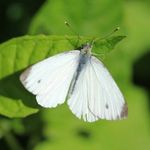 Cabbage moth and cabbage white butterfly have white or grey wings with distinctive markings. They lay their eggs on the underside of leaves. Their caterpillars feed on the leaves, creating large holes and sometimes skeletonising the leaves. Use netting to exclude butterflies and moths or decoys to deter them. Pick the caterpillars off the plants or use an appropriate spray in a selective and targeted way. Read more about cabbage moth and cabbage white butterfly here.
Cabbage moth and cabbage white butterfly have white or grey wings with distinctive markings. They lay their eggs on the underside of leaves. Their caterpillars feed on the leaves, creating large holes and sometimes skeletonising the leaves. Use netting to exclude butterflies and moths or decoys to deter them. Pick the caterpillars off the plants or use an appropriate spray in a selective and targeted way. Read more about cabbage moth and cabbage white butterfly here. Thrips are black, beige or white flying insects (<1.5mm) with larvae that suck tissue from leaves and petals, leaving behind very small white or transparent markings. While not usually causing serious damage, the marks affect the look of flowers and foliage and thrips can also transfer pathogens from one plant to another. Wash thrips from affected plants using a garden hose, encourage predatory mites and lacewings with companion planting, or spray with soap, eco-oil or neem oil.
Thrips are black, beige or white flying insects (<1.5mm) with larvae that suck tissue from leaves and petals, leaving behind very small white or transparent markings. While not usually causing serious damage, the marks affect the look of flowers and foliage and thrips can also transfer pathogens from one plant to another. Wash thrips from affected plants using a garden hose, encourage predatory mites and lacewings with companion planting, or spray with soap, eco-oil or neem oil.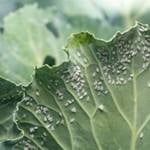 Whitefly is a sap-sucking insect related to aphids. They are often found in large numbers on the underside of leaves and will swarm in clouds when disturbed. Plants may have yellowing leaves or may wilt, and growth will be slowed. Whitefly can be removed with a garden hose or sprayed with soap spray. Badly affected plants should be destroyed. Attracting beneficial insects that will prey on whitefly can be beneficial. Read more about managing whitefly here.
Whitefly is a sap-sucking insect related to aphids. They are often found in large numbers on the underside of leaves and will swarm in clouds when disturbed. Plants may have yellowing leaves or may wilt, and growth will be slowed. Whitefly can be removed with a garden hose or sprayed with soap spray. Badly affected plants should be destroyed. Attracting beneficial insects that will prey on whitefly can be beneficial. Read more about managing whitefly here.


.png)



